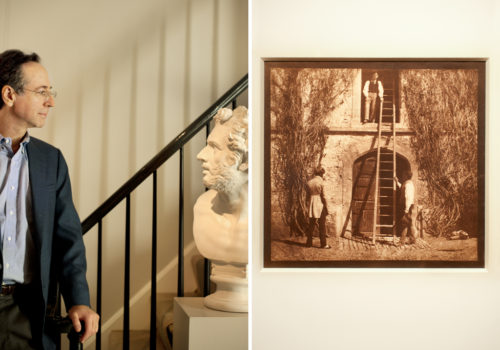Day 5
I’d been wanting to go for a long time. No, honestly. At least ever since my university days in Paris, where I studied British literature. That’s when I learned that Lewis Carroll wasn’t just a writer and that Virginia Woolf’s little group often toyed around with image-making.
Which is why I really wanted to see the Julia Margaret Cameron exhibition at Hans Kraus. But you had to make an appointment and I had never dared. Can you disturb a great art dealer when you just want to have a look? Well, I was wrong. I know it as soon as I see the infamous broom in a corner of the entryway – a sly reference to William Henry Fox Talbot, the gallery’s guardian angel – and the fantastic plants from the exhibition Flora climbing up the walls.
Inside Hans’s space, however, the walls are blue-gray, the curtains drawn and the lights dimmed, undoubtedly to protect the fragile treasures in his collection. A bust of Patroclus keeps watch at the bottom of the stairway – another Talbot reference. And everywhere, silence… As if the city had disappeared and time itself was letting itself take a break.
Then Hans comes down from his office, and we immediately began talking about his fascination for early prints, especially calotypes – exceptionally rare messengers from an earlier time.
The shoot takes place without incident. Shelley Dowell, an associate of Hans, comes in and takes on the role of fashion consultant: tie? No tie? Scarf? Or perhaps a jacket? I was too fascinated by the silent conversation going on between Hans and Patroclus in my viewfinder to help. I just keep pressing the shutter release, over and over…
Between two shots, I confess my fondness for Cameron’s work, and how disappointed I was to miss the show a few weeks ago. He looks up, smiles, and motions for me to follow him. He takes me away from the main space and into a private gallery, where six portraits (vintage wet collodion albumen prints) are hanging. Cameron took these in her studio on the Isle of Wight – including the celebrated transparent portrait of Virginia Woolf’s mother.
Unbelievable to be standing in front of masterpieces like this.
I’m transfixed by a portrait of an old man wrapped in what appears to be a dark blanket. Hans tells me it’s Henry Wadsworth Longfellow, the great American poet. He was on the Isle of Wight, where Cameron was living and working, to visit a friend they had in common: Alfred, Lord Tennyson. History has it that Tennyson “delivered” Longfellow to Cameron with this comment:
“This is Longfellow, you know him by name, now you know him in the flesh. I will leave you now. Longfellow, you will have to do whatever she tells you. I’ll come back soon and see what is left of you!”
I leave and step out into the pouring rain. No umbrella. But it doesn’t matter; it probably rains all the time on the Isle of Wight…
Thank you, Hans.
From his first encounter with photography to the opening of his own gallery space…
Hans says he was always interested in photography, ever since he was a little boy, although his famous father tried to persuade him to join the rare book trade.
As a young photographer, he was an admirer of Ansel Adams. But one day, he tells me, he realized that he had only limited talents and would never be as good as his hero. That’s when he began studying the history of photography, especially the period before Adams.
He discovered Daguerre and his unique prints, but he quickly became devoted to the early forms of negatives, especially the calotypes used by Talbot.
He conducted research on these vintage prints in many of the major museums, and soon he decided to tackle the market of photography prior to 1860.
He fine-tuned his knowledge of photographic history at Christie’s, first in London and then in New York. He founded the Hans P. Kraus Jr. Fine Photographs Gallery in 1984.
His best memory as a gallerist…
Hans tells me that in 2011, a man close to the Cameron family informed him that many of the artists’ works were transmitted from generation to generation and were still possessed by her descendants. Hans was able to acquire 40 pictures from these personal collections.
The first photograph he bought for himself, or one that has special importance in his life…
The first print he bought was Moonrise over Hernandez by Ansel Adams in 1977.
He sold it to prove to his father that photography was a viable business. He adds that he remembers all the prints he purchased, even if he resells them. To some extent, these pictures will always be a part of him.
One that has special importance for him is The Ladder by William Henry Fox Talbot – his only image with human figures – excerpted from the first printing of The Pencil Of Nature released en 1844.
This book is considered the very first to be illustrated with photos. It featured 24 photographic plates (architecture, still lives, portraits) as well as several texts about Talbot’s innovations. It was a major development for books and photography and helped advance Talbot’s lifelong project: to present photography as an art and not only as a documentary or scientific tool.
The Ladder is one of Talbot’s most famous pictures. Hans says there are several other prints, but none boasts such quality.
On his bedroom wall…
Pictures taken by his wife, the great portraitist Mariana Cook.
If he was a renowned photographer…
I didn’t ask Hans this question, and of course, won’t answer for him, but I have an inkling…☺
If he had to choose another job…
He’d be a collector. Though as a gallery owner, he pretty much is one already.
















